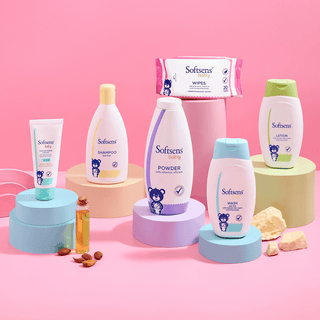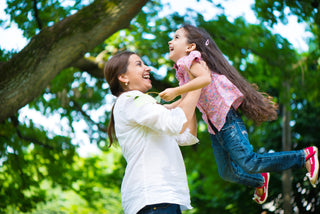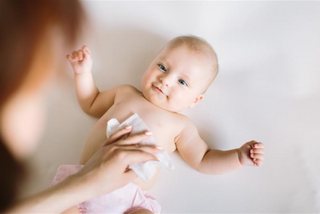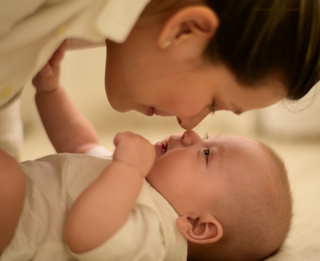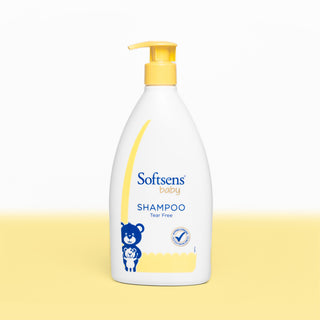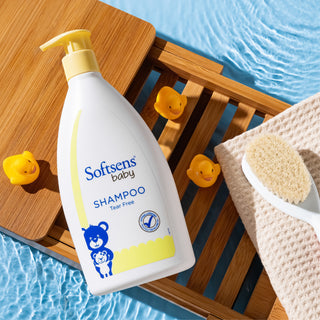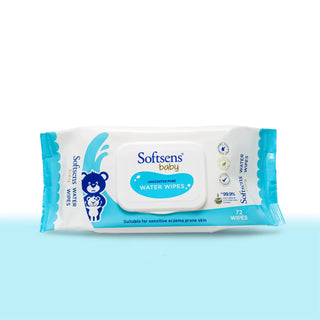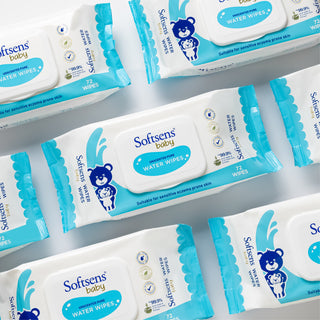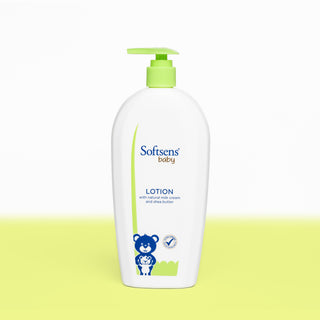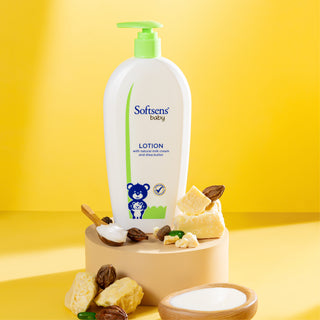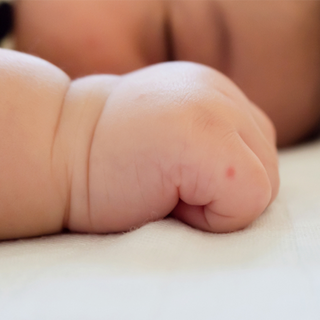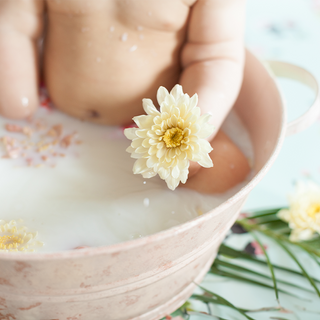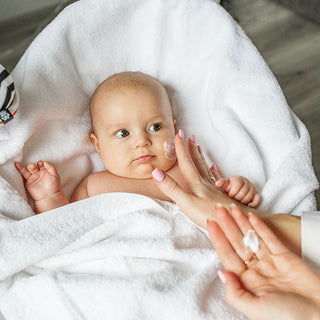
Until your baby is potty-trained, the trusty diaper is both your best and worst friend. This is a guide on everything you need to know about diaper changing and how to care for your baby's skin while you're at it. We'll cover all these important diapering questions and more.
-
How Often Does a Baby's Diaper Need to Be Changed?
-
How Do You Know When Your Baby's Diaper Is Wet?
-
Should You Wake a Sleeping Baby for a Diaper Change?
-
Understanding The Difference Between Cloth Diapers and Disposable Diapers
-
Your Diaper-Changing Essentials
-
How To Change Your Baby's Diaper: Simple Steps to Follow
-
Be Prepared: Essential Diaper Changing Tips On-The-Go
-
Happy Bottoms = Happy Baby
How Often Does a Baby's Diaper Need to Be Changed?
Making sure your baby's bottom is always clean and dry is an essential part of caring for your little one, and helps in preventing the dreaded diaper rash. However, babies urinate A LOT. On average, your little one will pee at least 15-20 times a day. So, does that mean you need to change your baby's diaper every single time? Not necessarily. You should change your baby's diaper every 2 hours or so, as a general rule of thumb, and when your baby's diaper is soaked. Most disposable diapers are pretty absorbent, and so, you won't need to change your baby's diaper every time there's a little pee, but if you feel that the diaper is wet, soaking or your baby seems uncomfortable, it's time to change that diaper. On disposable diapers, there is often a line that changes colour when the diaper is wet, which indicates that it's changing-time.
When it comes to poop, however, you need to change your baby's diaper as soon as possible to prevent any skin irritation. Fortunately, your baby won't poop quite as often as he/she urinates.
How Do You Know When Your Baby's Diaper Is Wet?
-
Feel the diaper for wetness, take a quick whiff or look inside
-
The diaper will feel heavy and full
-
Your baby might be irritable and show signs of discomfort
-
On disposable diapers, look out for the line that changes colour when wet

Should You Wake a Sleeping Baby for a Diaper Change?
Although there are mixed opinions on this, you don't need to wake a sleeping baby for a diaper change. Instead, wait 2-3 hours until the next feeding. If your baby is sleeping longer during the night, you don't have to wake her up to change her diaper. Simply change it right after the last feed before she goes to bed. You can also use night-time diapers that are thicker and more absorbent than regular diapers. If your baby's skin is extra sensitive or if you're concerned about wet diapers at night, apply a skin barrier cream or ointment as precaution.
Of course, if you notice your baby has pooped, you should change the diaper, no matter what time it is. If you do have to change your baby's diaper at night, do it in a manner that causes least disturbance to your baby, so that she goes back to sleep easily. Keep the lights dim, don't talk to or engage with your little one and try and gently put her back to sleep afterwards. If your baby wakes up for a night-time feed, change her diaper before you feed her and not after, so that she falls asleep easily after feeding.
Understanding the Difference Between Cloth Diapers and Disposable Diapers
While the debate around cloth and disposable diapers will never cease, we think that it's important to understand the advantages and disadvantages of both, and to then make a choice that works best for both you and your baby. Whatever choice you make, what really matters is that you keep your baby's skin clean and dry and follow proper diaper changing rules. Let's look at some of the key differences between cloth and disposable diapers.
Cloth Diapers:
-
Cheaper in the long run
-
Less absorbent and need to be changed far more often than disposable ones
-
Can be a little messier and less convenient, as your washing load will increase
-
Although the cloth diapers available today are easier to change and can be found in all types and sizes, those might be more expensive
-
Can be a gentler option for babies with extra-sensitive skin
-
Although cloth diapers are eco-friendlier, you will end up using more water in the cleaning process.
Disposable Diapers:
-
More expensive than cloth diapers
-
A lot more absorbent and made of breathable material
-
Far more convenient and can be easily disposed after use
-
Easier to change and more convenient while travelling with baby
-
Diapers with added fragrances and other ingredients can potentially irritate baby's skin
-
Not as eco-friendly as cloth diapers

Your Diaper-changing Essentials
The first rule of diaper changing is to make sure you have all your diaper-changing essentials ready so that you are prepared whenever you should need them. Once you have the right tools, changing your baby's diaper becomes easy, and soon, you'll even be able to do it blindfolded and with one hand behind your back. (Although we don't recommend you try that). So, here's everything you'll need to make the process easy.
-
-
Diapers:Whether you choose cloth or disposable, you'll need a LOT of these. Before you buy diapers, make sure you determine what size your baby will require.
-
Changing table/designated baby changing station: Considering you'll be changing diapers multiple times daily, it's best to have a safe and clean changing area where you can change baby's diapers easily. You can also store all your baby's diaper essentials here, so that they're within easy reach. Also make sure that the baby changing table is at a comfortable height for you.
-
Changing pad: This can be easily placed on the changing table or even on the bed or floor when you want to change your baby.
-
Diaper pail: This is your diaper collection box. Find one with a nice tight lid to contain the smell of all those soiled diapers:
-
Cotton pads, washcloth and/or Baby Wipes: You'll need these to clean your baby's skin thoroughly.
-
Diaper rash cream: It helps create a barrier between your baby's skin and the wet diapers, thus protecting skin.Click here to know more about diaper rash and how to prevent treat it.(new link to be added)
-
Other skincare essentials such as baby lotion and baby powder: Baby Lotion can help soothe dry skin and Baby powder helps absorb excess moisture and eliminates friction, keep baby's skin clean and dry.
-
Change of clothes: Messes and leaks are inevitable, so it's best to always have a change of clothes at hand, if you need them.
-
Toys to provide distraction: If you have a fidgety baby, hand her a toy to keep her occupied while you change the diaper.
-
Baby Diaper Bags: A practical bag to help you carry your diapering essentials when you're on the go!
-

How to Change your Baby's Diaper: Simple Steps to Follow
Learn all the best tips for diaper changing right here.
-
Before you begin, make sure you wash your hands properly. If you're outside and don't have access to soap and water, use hand sanitizer.
-
Keep all your diaper-changing essentials within reach, so that you can easily grab whatever you need while changing your little one. In fact, open up a fresh diaper before you begin and place it on one side.
-
Now, gently place your baby on her back on the changing table pad. If you're outside, find a clean, flat surface and place your changing mat on top of it. Some changing tables have safety straps to hold your baby in one place, but even so, it's important to make sure you have one hand on your baby to ensure she doesn't make any sudden movements.
-
Undress your baby or remove snaps/buttons for easy access to the diaper. Do a quick check to see if your baby's clothes have got soiled as well, in which case you would need to clean it up and change your baby's outfit.
-
Pull open the diaper tabs. Hold your baby carefully by the ankles and gently lift her bottom up so that you can slide the diaper out from underneath. Place the soiled diaper out of baby's reach, to be disposed of when you're done. If the diaper is not too messy, another way to do this is by folding the top half of the diaper over the bottom half and placing your baby's bottom on top of it while cleaning.
-
If you have a baby boy, then place a tiny cloth over his penis to prevent accidental pee showers while you clean him.
-
Clean your baby's diaper area thoroughly using either baby wipes or cotton balls dipped in warm water. Always start cleaning from the front towards the back, to prevent the spread of bacteria. Pay attention to the area between your baby's skin folds while cleaning. Gently pat skin with a clean cloth to dry the area well. (Choose between our gentle all-natural baby wet wipes 99.9% pure water wipes)
-
Once your baby's bottom is absolutely clean and dry, lift her legs once again and place the clean diaper underneath.
-
Apply any diaper rash cream or powder, if required.
-
Secure the fresh diaper by bringing the front portion of the diaper over your baby's belly and hold it there using one hand. Then, fasten the tabs on either side one at a time using your other hand.
-
If your baby's umbilical cord stump hasn't fallen off yet, then you could use newborn baby diapers that have a special cut-out for the stump so that it stays clean and dry. Or you could simply fold your baby's diaper down to avoid covering the stump.
-
The diaper should fit snugly to prevent any leakage but at the same time, it should be comfortable enough to let your baby's skin breathe and to prevent any chafing. If you notice red lines or marks while changing the diaper the next time, then it's probably too tight.
-
Finish up by putting your baby's clothes back on and placing her in a secure area.
-
Don't forget to dispose of those dirty diapers safely in your diaper pail and once again, wash your hands thoroughly.

Be Prepared: Essential Diaper Changing Tips on-the-Go
Being a parent means being prepared for anything, especially when it comes to diaper duty. But what happens when that inevitable blowout strikes while you're out and about? Fear not, fellow adventurers! Here are some essential tips to ensure a smooth (and hopefully odor-free) diaper change experience, no matter your location:
-
Pack a Portable Pit Stop:Invest in a well-equipped diaper bag with a designated changing pad. Disposable changing mats offer convenience, while wipeable fabric mats are more eco-friendly.
-
Stash the Essentials: Always have a good supply of diapers, wipes, a clean bag for soiled diapers, and a travel-sized diaper cream on hand. Consider adding hand sanitizer for extra cleanliness.
-
Location, Location, Location: Scout for suitable changing areas before venturing out. Public restrooms or baby changing stations in shops and restaurants can be lifesavers. When outside, a clean park bench in a pinch can work too (with your changing pad, of course!).
-
The Car is Your Ally: Your car can be your mobile changing station. Keep a spare changing pad and supplies in the trunk for unexpected emergencies.
By following these tips and being prepared, you can conquer diaper changes on-the-go and keep your little adventurer happy and comfortable!
Happy Bottoms = Happy Baby
That's a wrap, moms dads. With these newfound skills and a little practice, you'll be a diaper-changing pro in no time. Remember, every change is an opportunity to bond with your little one. Embrace the (sometimes messy) moments, and most importantly, don't be afraid to laugh at the occasional poop explosion (we've all been there!). With patience, preparation, and a positive attitude, you've got this! Now go forth and conquer those diaper changes with confidence!



